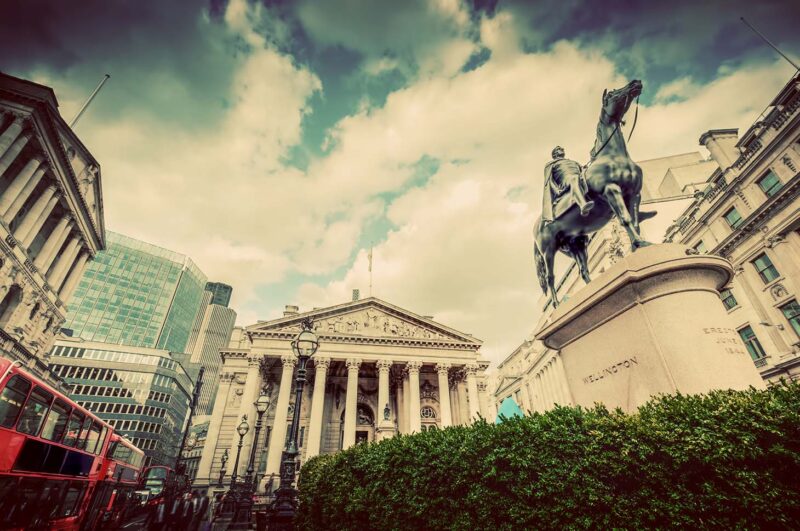How is money created?
It used to be a simple question.
At first, precious metals were money. But they can be inconvenient to deal with.
And so gold or silver would be held in a vault and a bank or a government would issue a piece of paper which allowed the bearer of that paper to redeem their metal. Instead of dealing in gold and silver, people dealt in the paper. That paper became money.
The word cash still referred to precious metal and you could have redeemed your bank notes for cash. That’s why our bank notes today still promise to pay the bearer of the bank note.
But, as yesterday’s Fortune & Freedom showed, even the Bank of England admitted this old promise no longer holds true in the same way. You can’t redeem your bank notes for gold or silver any more. Money is no longer backed by metal. Precious metals no longer play any role in how much money is created.
Instead, these days, money is created in a deeply problematic way. Problematic because it allows the amount of money to surge and tumble dangerously in ways that can destabilise the economy badly.
And no, I’m not referring to QE or government money.
How to create money
Put simply, money these days is lent into existence by banks. That sounds confusing, but it’s quite simple. It also happens to be the key to unlocking the inflation versus deflation debate – the theme in this week’s editions of Fortune & Freedom.
Let’s start with a question to highlight the process. When you spend money on your credit card, where does it come from?
Nowhere. It is created as an “I owe you”. The same goes for mortgages and banks lending to business.
The idea that banks can lend money into existence sounds absurd. But when you consider the transition of money itself over time, it begins to make sense. That’s why we covered the topic in such detail with the help of a reader yesterday.
Money went from being an asset (gold) to a promise to pay an asset (bank notes) to a promise to pay… well, as we discussed yesterday, nothing more than newer banknotes of different denominations.
The good news is that we just went on pretending that there’s still something physical of value backing our money. The bad news is that, without gold, the constraint on how much money can be issued disappeared. The limits today are purely regulatory – based on how much money and easily sellable assets banks must hold in reserve in case of a bank run.
If money is nothing more than a promise to pay money in return, then it makes perfect sense that our money is now created by lending. Lending is, after all, nothing more than a promise to pay money too.
In effect, money and debt are now the same thing – a promise to pay money.
But this is where our week’s themes of inflation and deflation come into play.
The money supply depends on borrowing and lending
The value of money is determined by its supply. How much of it there is.
If banks lend a lot, the supply of money goes up. That’s inflationary.
When borrowers repay their debts, this might sound like a good thing for the economy. And it is, in some ways. Lower debt is a smaller burden.
But repaying debt also reduces the money supply thanks to our modern financial system and how it creates money. Less debt means less money too.
And that’s dangerous because less money means deflation. And deflation when you have a highly indebted economy is dangerous, as we laid out yesterday. It makes debts harder to repay, leading to defaults.
Today, we discuss the crisis this can cause. A self-escalating downward spiral called a debt-deflation.
The debt deflation spiral
Imagine some sort of crisis strikes the financial system. A pandemic perhaps, just hypothetically speaking.
This causes people to repay their debts, default on them and/or borrow less. This has the effect of reducing the amount of money in the economy, as we’ve just carefully explained. And that causes deflation.
What happens next is the key. If deflation takes hold, it becomes harder for companies and mortgage payers to repay their debts. They default more and borrow less, which in turn reduces the amount of money again. That worsens the deflation.
You can tell the same story from the bankers’ perspective, if you can stomach it. If banks expect a downturn in the economy, they lend less and call in loans. This reduction in debt also reduces the money supply thanks to the way our financial system works. And that deflation worsens the financial position of borrowers, causing banks to become even more cautious.
Do you see the spiral and how it repeats? It’s self-reinforcing.
Now, if our money supply wasn’t dependent on lending and borrowing, the amount of money would be more stable. And the debt deflation wouldn’t happen in quite the same way.
But in the world we live in, expansion and contraction of the money supply is dependent on borrowing and lending.
My worry is that the Covid-19 crisis and the lockdown could lead to a debt deflation. The warning would be a collapse in borrowing, or a rise in defaults.
Has a debt deflation begun?
In July, Peer2Peer Finance News reported “Bank of England data shows lending [in the second quarter] has dried up faster than during the credit crunch”.
The Financial Conduct Authority reports that the value of UK gross mortgage advances in the second quarter of 2020 were down by one third over Q2 2019. The value of new mortgage commitments fell by more than half from over Q2 2019.
This chart from the Bank of England shows consumer credit growth (excluding student debt and credit cards) since 2015.

Source: Bank of England
Now it’s not all one way. Thanks to government programmes to help businesses to paper over their lockdown losses, lending to small businesses actually hit all-time record highs. But borrowing to survive a lockdown is not likely to last… and the defaults are coming.
In the US, The Market Ear blog recently pointed out that American bank consumer lending went from increasing by about $40 billion a year over the previous years to decreasing by about $90 billion in the year to 28 October.
World Property Journal reported on the US mortgage market:
Based on a new forecast released this week by the Mortgage Bankers Association, commercial and multifamily mortgage bankers are expected to close $395 billion of loans backed by income-producing properties in 2020, a 34 percent decline from 2019’s record volume of $601 billion.
You get the idea…
The contraction in debt and money hasn’t gone unnoticed though. But the response is famously…
Pushing on a string
The response to the problem of falling lending is for the central bank to print more money. But these funds don’t actually impact the economy in a way that fights off inflation, unless the banks increase lending. It is, as economists refer to it, pushing on string.
This phenomenon explains why huge amounts of QE haven’t led to inflation these past few years. The QE hasn’t kick-started lending by the banking system, thereby increasing the money supply.
The key question is whether banks will lend and people will borrow, not whether central banks print money.
But how much focus have you seen on that question – forcing people to borrow and forcing banks to lend?
Actually, for the first time, thanks to Covid-19, governments really are pressuring or incentivising banks to lend in ways they hadn’t before. Programmes like the UK’s bounce-back loans, for example.
For now, these are an emergency measure. But there’s nothing as permanent as a temporary government programme, explained economist Milton Friedman.
This means we may finally see the increase in lending needed to generate inflation. But it will take an initial deflationary shock to spur governments to force banks to lend.
The question is whether that’s already happened thanks to the current Covid crisis or not. And, now that you’re armed with all you need to know to understand the discussion, that’s what I’m going to ask Nigel Farage.
Inflation or deflation?
Stay tuned.

Nick Hubble
Editor, Fortune & Freedom




